Why is hydroponic farming the answer?
Hydroponics is a subset of hydro culture, which is the growing of plants in a soil less medium, or an aquatic based environment. Hydroponic growing uses mineral nutrient solutions to feed the plants in water, without soil.
Advantages of hydroponic farming
- No soil is needed for hydroponics.
- The water stays in the system and can be reused – thus, a lower water requirement.
- It is possible to control the nutrition levels in their entirety – thus, lower nutrition requirements.
- No nutrition pollution is released into the environment because of the controlled system.
- Stable and high yields.
- Pests and diseases are easier to get rid of than in soil because of the container’s mobility.
- Ease of harvesting.
- No pesticide damage.
Types of Hydroponic systems?
When you think of it, you instantly imagine plants grown with their roots suspended directly into water with no growing medium. However this is just one type of hydroponic gardening known as N.F.T. (nutrient film technique). There are several variations of N.F.T. used around the world and it is a very popular method of growing hydroponically. There are countless methods and variations of hydroponic gardening.

WICKS HYDROPONICS SYSTEM
Seen as the most simplistic hydroponic system. The Wick system is described as a passive system, by which we mean there are no moving parts. From the bottom reservoir, your specific Growth Technology nutrient solution is drawn up through a number of wicks into the growing medium. This system can use a variety of mediums, perlite, soil or coco.
Plant roots grow down through a medium while an absorbent “wick” draws nutrient-filled water up from a water reservoir to the root system zone. The growing medium allows for air (oxygen) to reach the roots.
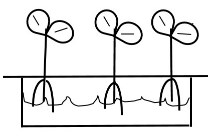

WATER CULTURE HYDROPONICS SYSTEM
This system is an active system with moving parts. As active hydroponic systems go, water culture is the simplest. The roots of the plant are totally immersed in the water which contains the specific Growth Technology nutrient solutions. An air pump with help oxygenate the water and allow the roots to breathe.
NOTE. Very few plants other than lettuce will do well in this type of system.

EBB AND FLOW HYDROPONICS SYSTEM( FLOOD AND DRAIN)
This hydroponic system works by temporarily flooding the grow tray. The nutrient solution from a reservoir surrounds the roots before draining back. This action is usually automated with a water pump on a timer.
Plant roots grow through a medium. Nutrient-filled water is pumped on a frequent basis (e.g., every 30 minutes) to the root zone area and allowed to drain back into a water reservoir.
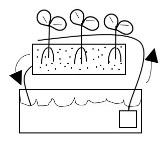
.
DRIP HYDROPONICS SYSTEM(RECOVERY OR NON RECOVERY)

Dip systems are a widely used hydroponic method. A timer will control a water pump, which pumps water and the Growth Technology nutrient solutions through a network of elevated water jets. A recovery system will collect excess nutrient solution back into the reservoir. A non-recovery drip system will avoid this allowing the phof the reservoir not to vary.
.

NUTRIENTS FILM TECHNIQUE HYDROPONICS SYSTEM(N.F.T)
The N.F.T system is at the forefront of people’s minds when hydroponics is mentioned. Nutrient Film Technique uses a constant flow of your Growth Technology nutrient solution (therefore no timer is required). The solution is pumped from a reservoir into the growing tray. The growing tray requires no growing medium. The roots draw up the nutrients from the flowing solution. The downward flow pours back into the reservoir to be recycled again. Pump and electric maintenance is essential to avoid system failures, where roots can dry out rapidly when the flow stops.
Plants are positioned on a floating surface hanging in a trough that is slightly tilted. The plant roots hang with the upper part of the root system exposed to air (oxygen). The bottom part of the roots is exposed to nutrient-filled water that is pumped into the trough at the upper (higher) end. The water flows past (down) the other root systems and back into a water reservoir.
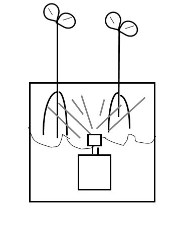

AEROPONIC HYDROPONICS SYSTEM
Aeroponic systems are seen to be a high tech method of hydroponic growing. Like the N.F.T system the growing medium is primarily air.
The roots hang in the air and are misted with nutrient solution. The misting of roots is usually done every few minutes. The roots will dry out rapidly if the misting cycles are interrupted.
A timer controls the nutrient pump much like other types of hydroponic systems, except the aeroponic system needs a short cycle timer that runs the pump for a few seconds every couple of minutes.
AIR GAP HYDROPONICS SYSTEM
Plant roots hang partially in nutrient-filled water while the upper part of the root system is exposed to air (oxygen).
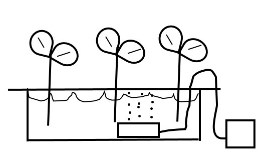
RAFT HYDROPONICS SYSTEM
Plants are positioned on a floating surface with their roots hanging in nutrient-filled water. An aquarium-type pump supplies oxygen to the water which is picked up by the roots.
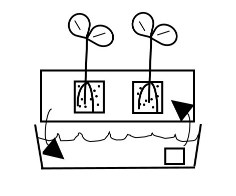
TOP FEEDER HYDROPONICS SYSTEMS
Plant roots grow through a medium. The growing medium allows for air (oxygen) to reach the roots. Nutrient-filled water is pumped to the top of the medium, allowed to percolate down to the root zone, and then drained back to a water reservoir.
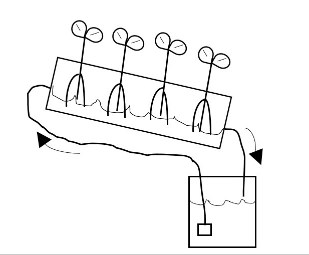
AEROPONICS HYDROPONICS SYSTEM
Plant roots are positioned in an enclosed space and exposed.
